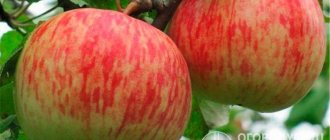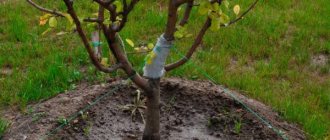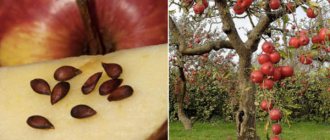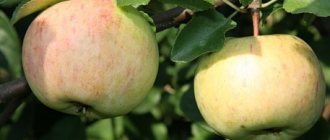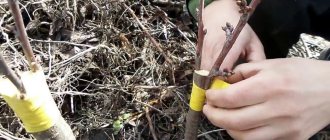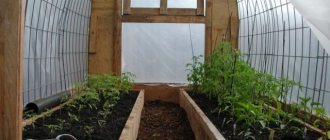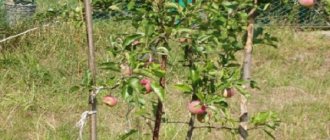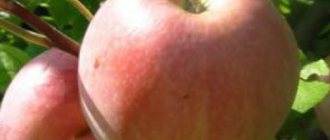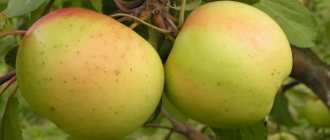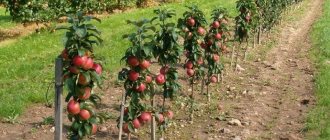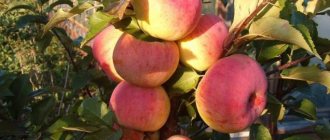Many novice gardeners do not pay enough attention to preparing the planting hole. Most gardeners dig such holes immediately before planting seedlings, which in turn leads to certain problems with tree growth, and in some cases, seedlings simply die without taking root in a new place. How to properly prepare such a hole for planting an apple tree.
Which apple tree to plant: choosing varieties
When you choose a variety for planting, pay attention to the three most important parameters:
- fruiting time – how many years will it take you to harvest your first apple crop?
- taste characteristics
- ripening time
All types of apple trees are divided into three main groups - summer, autumn and winter.
Summer varieties produce a harvest already in July-August. These include:
- the domestic variety of folk selection Grushovka (also called Grushovka Moskovskaya or Skorospelka), begins to bear fruit a year after planting
- Red early , the harvest period reaches the month of July
- Melba , produces tasty and juicy fruits
- White filling with large fruits 100-150 grams yields a harvest in the first half of August
Grushovka is a frost-resistant variety that grows well in all regions with a changeable climate, including the Urals and Siberia.
Autumn varieties ripen in September-October, depending on the region:
- Zhigulevskoe with large fruits 130-200 grams of pleasant sweet and sour taste
- Orlovskoe striped - late autumn apple variety
- Pervinka is a winter-hardy and productive variety
Winter apple trees are good because their fruits can be stored for a long time while maintaining their taste characteristics. Plus, they handle transportation well. The most famous winter varieties are:
- Antonovka vulgaris , a variety of folk selection, vigorous and high-yielding
- Bogatyr is a vigorous and productive variety, resistant to scab and fruit rot.
- Lobo begins to bear fruit from 4-5 years, the fruits are well stored until February-March
How to choose apple tree seedlings for planting
Apple trees are planted as seedlings on a garden plot. They can be purchased at special nurseries or from private traders. When choosing, pay attention to the condition of the seedling, whether it has external damage or peeling of the bark.
The root system requires special attention, however, this is only visible if you purchase apple tree seedlings with an open root system. The more developed it is, the greater the chance that the tree will take root.
Healthy, damage-free apple tree seedlings are the key to a large harvest
You should prefer seedlings with large roots rather than large shoots and branches. The roots must be intact.
The seedlings may already have awakened buds, but this is only permissible if the purchase occurs shortly before planting in open ground.
Selection and preparation of seedlings
Apple tree seedlings can be purchased at a nursery or purchased from private gardeners. When purchasing, be sure to find out the type of apple tree, the requirements for the composition of the soil and the features of caring for the trees. One-year and two-year apple trees are suitable for planting. They are easy to distinguish - two-year-old seedlings have time to grow side branches. One-year-old seedlings take root better, but two-year-old seedlings will begin to bear fruit a year earlier.
When choosing seedlings prepared for sale, pay attention to their root system. The root should have triple branches, each of which is 30 cm long. The presence of numerous fibrous roots is important - they help the tree to take nutrients and moisture from the soil. The root system of the seedling should be moist, the root sections at the ends should be white. If the sections are brown, it means the tips of the roots have dried out or were frozen; before planting, they are trimmed a couple of centimeters to get to the living tissue.
To protect the roots of the seedling from drying out during transportation, they are wrapped in damp cloth. Before planting, it is recommended to treat the roots in the traditional way - dip them in a liquid mixture of water, clay and cow dung, and then dry them a little. This procedure not only protects the roots from drying out, but also helps to feed the plant during the first time after planting.
Planting apple tree seedlings in open ground in spring
Apple trees are planted in open ground both in spring and autumn. Moreover, most often gardeners prefer to do this in the spring, since here, as they say, nature itself helps.
The dates for planting apple trees are at the end of April, starting on April 20. Of course, it's worth looking at the weather and the region. In the Moscow region, it makes sense to plant seedlings on April 20-30, but in the conditions of Siberia, the Urals and the Far East, it is better to focus on May.
Although apple trees will thrive in any open ground, deep loamy soils are best suited for growth. Peat, compost, and coarse river sand are added to clay ones, since seedlings and mature trees cannot tolerate a lack of air in the soil.
If the soil is sandy, then it is necessary to add a large amount of peat, clay soil, humus and compost.
Features of soil types
The ideal option for planting an apple tree is fertile black soil. But it is not everywhere, so we need to make do with what we have and improve the soil structure as much as possible.
Varieties of soils in the garden plot.
Clayey
Clay soil is very heavy and does not allow moisture to pass through. Too much density makes it difficult for plants to receive oxygen and water. Therefore, it will help to improve the structure of the clayey area:
- river;
- sand;
- sawdust;
- compost;
- peat land.
All this is added to the plot, and this mixture helps to make it more suitable for planting an apple tree.
If possible, it is recommended to carry out this procedure a year in advance and plant green manure in this area to enhance the effect. At the end of the season they are cut off and buried in the ground. And in the spring you can plant an apple tree in this area. Fertilizers you will need:
- nitroammophoska;
- superphosphate;
- potassium sulfate.
Peat
Although peat soil allows air and moisture to pass through well, it contains too few nutrients and is often too acidic. In order to reduce acidity, or rather, normalize it, you need to add:
- lime;
- chalk;
- or dolomite flour.
If the area lies flat, then it needs to be dug up, sand and humus added. If timing allows, then it is important to carry out an identical procedure with planting green manure.
Sandy
To improve the structure of sandy soil and help it retain more moisture and air, you need to add some clay to the area. Organic matter and compost can also be added, and minerals will require potassium and superphosphate.
Loamy
Although loam is not nutritious enough for planting an apple tree, it is the easiest to prepare. Only potassium sulfate, superphosphate and compost or rotted manure are added.
How to plant an apple tree correctly: 8-step instructions
In order for the apple tree to take root better, it is better to follow the correct sequence of actions.
For convenience, we have prepared detailed instructions with photos and divided the entire process into 8 simple steps. The starting point is that you already have a healthy seedling that you plan to plant in open ground. So, let's go!
- Prepare holes for planting
Holes for planting vigorous varieties of apple trees are dug at a distance of 5x5 meters, for varieties with a medium crown - 4x4 m, for varieties on semi-dwarf rootstocks - 4x3 m, for varieties with dwarf rootstocks - 3x2 meters.
The holes are dug to a depth of 70 cm, with a diameter of 100-110 cm.
The upper, humus layer is folded to one side of the pit, the lower, infertile layer - to the other.
In terms of timing, it is best to dig holes 7-10 days before planting seedlings in open ground.
When preparing a hole for planting an apple tree, it is more convenient to remove the upper humus layer in one direction, and the lower, infertile layer in the other.
- Loosen the soil at the bottom of the hole
The bottom of the hole for seedlings must be loosened for planting to a depth of 25-30 cm, while the loosened soil remains in the hole. It is most convenient to do this with a crowbar or a sharp and heavy shovel.
- Prepare the soil for planting
Small tin cans and walnut shells are thrown into the bottom of the pit.
After this, the top, humus layer is poured into the pits, filling it by one third, then mineral and organic fertilizers are added: 1 glass of superphosphate, 4 tablespoons of potassium sulfate, 10 tablespoons of wood ash, 3 buckets of manure humus. Next, the fertilizer is mixed with the soil with a shovel, adding more fertile soil to half the hole.
- Prepare a mound for planting seedlings
Then the rest of the hole is filled with fertile soil, but without fertilizers. It is necessary to fill the ground so that a mound is formed above the full hole 15-20 cm above the soil level.
- Drive a wooden stake
A wooden stake must be installed and driven into the center of the resulting mound, which should rise 40-50 cm above the pit.
- Plant an apple tree seedling
Now your apple tree is ready to be planted in open ground.
It is more convenient to plant a seedling together. One gardener places the seedling in the center of the hole on the north side of the stake, lifting it so that the bark neck is 5 cm above the soil level. Another, holding a seedling, spreads the roots in all directions along the mound and at the same time covers the root system with fertile soil. At the same time, the added soil is carefully trampled down, compacting the edges of the hole especially tightly.
Scheme of planting a seedling in a hole - on the right is the correct option, on the left is the wrong one
- Tie a seedling
The apple tree must be tied to a stake in a figure eight pattern; it is better to use polyethylene twine.
- Water and mulch
Next, you need to water the planted seedling with water. It is worth watering until water easily passes into the hole. You will need a lot of water, 4-5 buckets, it is more convenient to prepare for watering in advance.
Then they mulch with humus, peat or just soil in a layer of up to 5 cm.
After a week, watering is repeated.
Congratulations! At this stage, you can take a break, and the apple tree will need to take root in the open ground.
Here is another scheme for planting apple tree seedlings, this time in the form of instructions in one photo:
Instructions for planting an apple tree in one picture
For your convenience, we are also posting video instructions on how to plant an apple tree - from choosing a seedling to feeding:
Planting an apple tree with a closed root system: features
Some apple trees are grown immediately in a plastic container or container, this is called a closed root system. When selling, seedlings are not dug up, and the roots are not freed from the ground, thus the earthen ball is preserved along with the root system.
When planted, such trees have a number of characteristics.
Firstly, they take root at any time of the garden calendar, from April to October.
Secondly, such seedlings are easier to transport and, if necessary, store before planting in open ground.
Thirdly, these are the landing features.
The technology for planting apple trees with a closed root system is as follows:
- The integrity of the earthen clod must not be violated
- The earthen ball must be watered the day before planting in open ground, the soil must be completely wet
- It is necessary to remove the seedling from the container very carefully: small roots may stick to the walls of the container and be damaged. Use a sharp long knife.
For apple trees with a closed root system, it is important not to damage the earthen ball when planting
Why seedlings may die
Sometimes gardeners have a logical question: they planted the apple tree correctly, followed all the instructions 100%, but the apple tree did not take root and died - what’s the matter?
Unfortunately, this can happen, and the main reason is the close occurrence of groundwater. And if you know that this is the case on your site, in order to improve the survival rate of seedlings and then reap a decent harvest, you need to plant on hills. This is the so-called “planting an apple tree on a hill.”
To do this, dig up an area with a diameter of 3-3.5 meters to the depth of a shovel, then scatter organic and mineral fertilizers at the rate of 1 bucket of manure humus, peat or compost, as well as 2 tablespoons of superphosphate and potassium sulfate for each square meter of soil. Fertilizers are leveled with a rake, and then fertile soil is poured in a layer of up to 60-70 cm.
In the center of the hill, seedlings are planted in the same way as in a hole. The roots must be compacted, the apple tree is tied to a stake and watered abundantly.
You can also use this scheme for planting apple tree seedlings on a hill if the groundwater is too close
Important! If you grow apple trees in open ground with close groundwater, you need to dig ditches nearby to drain the water
Carrying out pre-planting work
Planting an apple orchard is carried out using a single technology, independent of the time or region of planting. But some activities have their own characteristics, which are determined in accordance with the characteristics of a particular site, soil composition, the presence of buildings and other factors.
Selection and processing of seedlings
Before planting an apple tree from a nursery, you need to choose the right variety, taking into account the area of the site and the depth of groundwater:
- for a small garden it is recommended to purchase columnar, dwarf and low-growing species;
- when water occurs at a depth of less than 2.5 m, low- and medium-sized varieties are suitable;
- tall varieties can be planted if the aquifer is located lower.
Planting material should be purchased from a local nursery so that the trees are adapted to regional conditions. Plants aged 1–2 years with the following external characteristics will be optimal:
- smooth trunk without damage or growths up to 1.5 m high;
- the presence of 2–3 branches on it, extending at an angle of 45–90°;
- flexible roots 40 cm long;
- the bark inside is green if scratched slightly;
- on trees with an open root system, the leaves should not bloom.
Related article:
Easy adaptation of an apple tree in the garden: 5 rules for autumn planting apple trees
Since nurseries offer a wider selection of seedlings in the fall, you can buy them at this time and then store them in the basement until spring, placing them in boxes and covering the roots with soil.
Preplanting preparation of seedlings is carried out according to the following scheme:
- carefully inspect and trim off damaged roots;
- immerse in water or growth stimulator solution for 12 hours.
It is important that the seedling has a well-developed root system and a not very large above-ground part. If it’s the other way around, then the branches are cut to length.
Place, landing scheme
Since apple trees can be planted correctly only in a suitable area, when choosing it you need to take into account the crop requirements for growing conditions:
- apple trees love sunny, elevated places without accumulation of groundwater and stagnation of moisture after precipitation;
- Before planting an apple tree in low-lying areas with close groundwater, you need to build an artificial embankment:
- in any case, the place must be protected from the north from cold winds with the help of some kind of building or structure.
Related article:
How to organize proper care of apple trees to achieve a high yield
When planting several trees, you should first draw up a diagram, since incorrect placement will be almost impossible to correct.
To avoid mistakes, when drawing up a diagram, you need to know how to properly plant apples in one garden:
- tall ones are placed at intervals of 5–7 m;
- medium height – 3–4 m;
- short and dwarf – 1.5–2 m;
- columnar - 0.5 m.
Plantings that are too sparse will be irrational in terms of land use, and plantings that are too dense will create a lack of space and light, which will reduce yields and increase the risk of disease development. Only the right conditions for planting an apple tree and a competent garden design will ensure its development for many years.
Preparing the soil and planting hole
Apple trees are undemanding to soil and grow poorly only in salt marshes. But for their good development, the necessary agrotechnical measures are required during planting and further care.
Related article:
Decorative apple trees
The ideal soil for planting an apple tree is light loam. If the soil does not meet these characteristics, then when digging, add the following:
- in clayey - sand (2:1);
- in sandy - peat and humus (2:1:1).
In spring, the hole is prepared 2 weeks before planting the apple, but it is better to do this in the fall. For autumn planting, the pits are prepared 4–6 weeks before work.
To determine at what depth to plant seedlings, you need to take into account the growth of the variety and the grafting method. Dimensions depending on height should be as follows:
| Tallness of the variety | Dimensions of the landing pit | |
| Depth, cm | Diameter, cm | |
| High | 70 | 110 |
| Average | 60 | 100 |
| Short | 50 | 90 |
By vaccination method:
- with high budding (20-25 cm above the root collar) - deepen 10–15 cm above the neck, which will lead to the formation of an additional layer of roots that will strengthen the tree;
- with low budding - the grafting site should be strictly at ground level;
- Planting a grafted apple tree with budding at the root collar is done without deepening, so as not to fill the root collar.
Deep planting is considered more beneficial for the tree, but it has a significant drawback - it slows down the onset of fruiting.
Before planting apples, one of the following mixtures is added to the planting hole:
- add 200 g of superphosphate and 150 g of potassium chloride to a bucket of manure, and for acidified soil – also 1 kg of dolomite flour;
- per bucket of manure - a bucket of peat and sand, 400 g of nitroammophoska.
Related article:
Easy adaptation of an apple tree in the garden: 5 rules for autumn planting apple trees
The main thing is to use only rotted manure, since fresh manure can burn the roots during the process of rotting.
Planting under an apple tree
If you did everything correctly, then the distance between the planted apple trees is from 3 to 5 meters. These row spacings can be used for growing vegetable crops, as is done correctly until the trees are 5 years old.
The best crops for planting are early radishes, early cabbage, peas, beans, beans, physalis and early low-growing tomatoes for open ground. Their shallow root system and constant care - watering, weeding, loosening, fertilizing and processing - contribute to good growth and development of the apple tree.
Tall crops such as sunflower and corn cannot be sown around young apple trees, as they greatly shade and dry out the soil.
In a young garden, the soil between the rows can be used to grow not only vegetables, but also green manure crops - mustard, lupine and buckwheat. It is especially useful to sow these crops in gardens located on slopes - they protect the soil from erosion. This way the soil freezes less, and more snow accumulates between the apple trees. If green manure is sown on a flat area, then during flowering it is mowed, crushed and used as fertilizer, which improves its structure. Green manure does not mow down our slopes - they disappear before winter.
How to properly prepare a planting hole
Whatever crop you decide to plant on your site, the general algorithm for creating a planting hole will be the same for everyone. Let's look at the main points:
- The most common and convenient shape for a planting hole is a circle. A round hole is more convenient to dig than a rectangular one, and it is ideal for the development of roots, because the root system grows radially.
- To draw a circle of the required diameter, make a design that resembles a compass. To do this, drive a wooden or metal peg into the center of the future planting hole. Tie a cord to it, the length of which is equal to the radius of the hole. Attach another peg to the opposite end of the cord and draw a circle on the ground with the resulting “compass”.
- From the entire area of the circle, remove the top layer of soil to the depth of a shovel - this is the most fertile part of the soil - and set it aside. Then dig the hole to the required depth and take out all the excavated soil, because... you won't need it in the planting hole.
- Add the required amount of fertilizer to the reserved top layer of soil (more on this below) and mix everything thoroughly. Fill the planting hole with the resulting nutrient mixture and lightly compact the soil. So it will lie for several weeks until planting, gradually saturating the soil with useful substances.
Caring for young apple trees after planting
Caring for young apple trees consists of watering, preventive treatments against pests and diseases, as well as fertilizing.
In the first year, root feeding is done in early spring, and two foliar feedings are done in May and June.
For root feeding, 4 tablespoons of liquid organic fertilizer Potassium Humate “Prompter” for fruit and berry crops and “Effecton-O” are diluted in 10 liters of water; 15 liters of solution are consumed per tree.
Mineral fertilizers should be calculated at 15 liters per seedling
Foliar feeding of young apple trees is done with the growth regulator “Emistim”: 1 ml is diluted in 100 liters of water. This feeding is repeated after 20 days.
In subsequent years, starting from the second, before the start of fruiting, in addition to the listed fertilizing, in September, root fertilizing is carried out with phosphorus-potassium fertilizers (2 tablespoons per 10 liters of water), spending 20-30 liters on each tree, depending on its age.
To protect apple trees from pests in the spring, read the article about this.
When to dig a hole for an apple tree
In the literature you can find a recommendation to prepare planting holes in the fall - for spring planting and in the spring - for autumn planting. It is clear that an ordinary summer resident does not always plan his work so clearly, and besides, there is always the possibility of buying an “unplanned” seedling during the planting season. If necessary, the planting hole can be prepared urgently - right before planting the seedling, but it is still advisable to do this a little in advance, at least a month in advance, and only then go for planting material.
When to dig a hole for an apple tree
Quick answers on the topic “Planting an apple tree”
We decided to introduce an experimental part to the article, which will be called quick answers. It will be useful to those who want to find information quickly, without unnecessary details. If you want the details, you can read them above. If the section is useful, it will be added to other articles.
How to preserve apple tree seedlings before planting?
Seedlings must be stored in a “resting state” - at a temperature of 0 to +5 degrees. A good option is in the basement. If long-term storage is required, it is better to cover the apple trees with coniferous branches from rodents.
It is also important to remember that if the seedling was in a warm room where the temperature was +20 degrees or higher, planting is necessary within the next 24 hours, otherwise the plant may die.
What fertilizers should I use when planting?
When planting apple trees, mineral and organic fertilizers are added: superphosphate, potassium sulfate, wood ash, manure humus
When is the best time to plant an apple tree?
Apple trees can be planted both in spring and autumn. As practice shows, seedlings take root better in the spring.
When to plant apple trees in spring?
It is better to do this when the earth has already warmed up after winter. The best time for planting is the end of April (from the 20th) and all of May.
When to plant apple trees in the fall?
The optimal period is from September 20 to October 15. It is better to dig in the apple trees later on October 20, and carry out full planting in the spring.
At what distance should apple trees be planted?
This depends on the height of the variety (not seedlings!), the optimal distance is 4-5 meters.
What apple trees are best to plant?
The most common varieties are Grushovka, Melba, Medunitsa, Belyi Naliv, Antonovka and Bogatyr.
Is it possible to plant a new apple tree in the place of an old tree?
It is highly not recommended to plant a seedling in the same hole where the old apple tree grew. Firstly, over the years the earth has become impoverished, and harmful substances could accumulate there, especially if the old tree was sick. Secondly, the remains of the dying roots of the previous apple tree will interfere with the growth and development of the seedling.
When planting, step back at least a couple of meters from the old hole. If this is not possible at all (for example, the space on the site is very limited), in place of the uprooted apple tree, you need to replace the soil with fresh fertile soil on an area of 1 square meter, which can be mixed with rotted manure (2-3 buckets) and phosphorus and potassium fertilizers (1 matchbox each), or wood ash (1 liter).
Is it possible to grow greens (parsley, dill or onions) in the roots of an apple tree?
This question arises if there is not much space on the site.
It is worth remembering here that vegetable plants grow poorly in the tree trunks of fruit trees, including apple trees. Dill, parsley, chives and peas are very demanding in terms of light, and you will not get good results from growing them in such conditions.
How much do apple tree seedlings cost?
250-300 rubles for common varieties, for more rare varieties the price can reach up to 1000-1200 rubles.
Seedling preparation
For better survival, some manipulations are performed with the purchased seedlings. Usually it trims roots, shortens stems, and soaks roots.
Root pruning
Saplings with an open root system are inspected. Roots that are too long are slightly trimmed so as not to bend them in the hole. Dried and broken parts of the roots are removed.
Trimming the above-ground part
Before planting, the seedling is shortened so that its height does not exceed 0.9 m. The branches extending from the grafting site and 40 cm above it are cut off completely. Other branches are made shorter by 2/3 of the original length.
Advice! If you have a choice, it is better to purchase a seedling that has not been pruned. This will ensure that it is not grown beyond the permissible limit.
Soaking the roots
Planting rules require soaking the roots in water for 100% rooting. They should stay there for about a day. A little heteroauxin and a pinch of potassium salt are added to the water.
Apple tree nutrition and soil: useful tips
There are a lot of nuances, when and how it is better to plant a plant, rather than fertilize it, etc. Let's give a few gardening secrets:
- potassium fertilizers can be replaced with the ash of burnt trees, which contains a sufficient amount of this element. When it is applied, the soil will be healthier and less in need of improvement;
- The volume of fertilizing for apple trees must be calculated based on the estimated area of the projection of their crown. For example, 1 square meter of crown projection requires a bucket of manure or bird droppings;
- excess manure, especially true for clay soil, can cause the plant to burn;
- There is no need to apply a lot of nitrogen-containing fertilizers to the apple tree in the fall. It is better to get by with phosphate and potassium species;
- all potash fertilizers, including organic ones, act more slowly than nitrogen and phosphate fertilizers. Therefore, it is better to introduce them in the fall, so that the plant absorbs the form most convenient for this element;
- burnt buckwheat husks can be used as potassium fertilizer;
- Horse manure is considered the best, followed by pork. The most common, cow manure, is significantly inferior in quality to all of the above types of manure, including bird droppings;
- Sunflower husk improves the composition of clay soil and can serve as good compost;
- It is more effective to add various microbiological preparations used for planting apple trees not into the pit itself, but into compost or humus;
- The fertility of sandy soils increases the sowing of seradella green manure. It grows well in such conditions and does not require watering;
- when filling the planting hole, do not forget that the most nutritious soil should be closer to the root;
- When choosing a seedling, pay attention to the number of “hairs” on the root system. The more there are, the higher the likelihood that the apple tree will be well received.
This is not all the advice on preparing a hole for planting an apple tree. Gardeners from different regions know their secrets, proven over the years. Using them you can grow a wonderful apple at home.
